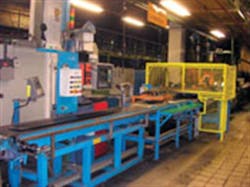What happens in Germany does not always stay in Germany, much to the relief of Continental Tire North America Inc. (CTNA).
Representatives from Continental AG’s North American subsidiary recently invited Modern Tire Dealer to Frankfurt for a look at its global business model, and how that affects tire dealers in the United States.
The media trip included a tour of the company’s 100-year-old Korbach, Germany, plant, which supplies winter tires to the U.S. and Canada. The plant has remained a viable production facility by reinventing itself as a niche market tire manufacturer.
More than one million tires
“We send a lot of tires to North America,” says Lothar Salokat, Korbach’s plant manager.
Last year, Korbach — one of Continental’s two consumer tire plants in Germany — produced a record 10.6 million tires; 10% to 15% were sent to the U.S. and Canada. Salokat estimates production will rise to 10.8 million tires in 2008.
The plant produces 34,400 passenger tires a day, of which 80% are allocated for the replacement market. Winter tires, including the General Altimax Arctic and run-flats, account for 55% of production. Korbach also studs up to 2.9 million winter tires using a fully automated process it learned after purchasing Gislaved in 1992.
The goal is to manufacture an average of 19.8 tires per minute, or between 9,500 and 10,500 per shift per day. That averages out to 206 tires per employee per day.
One of the ways the plant has survived is improving productivity, says Salokat. Another is adding capacity; 10 more presses are being added to the plant this year, which will increase the number of presses to 152.
Forklift (up to 25 inches), bicycle and motorcycle tires also are manufactured in Korbach. Some are exported to the U.S., according to Salokat.
The nearly one million-square-foot complex is located about 124 miles from Continental’s headquarters in Hanover, Germany.
It houses tire manufacturing, ContiTech hose manufacturing, a warehouse and a distribution center. The warehouse holds 1.3 million tires.
“Korbach shows you can survive in a (high-cost, unionized) plant,” says Andreas Gerstenberger, executive vice president of sales and marketing for CTNA.
[PAGEBREAK]
The “new” Continental
The purchase of Siemens VDO Automotive AG in 2007 instantly made Continental AG a top five global automotive supplier.
Dr. Burkhard Wies, vice president of replacement passenger and light truck tire line development worldwide, says there are four “megatrends” in the automotive industry, and Continental AG is heavily involved with all of them. The industry megatrends are:
1. safety (chassis, interior systems, tires),
2. the environment (conservation of natural resources),
3. information (sophisticated information management in the vehicle), and
4. affordable cars.
The key, he says, is to make affordable cars that incorporate safety, environmental and information advancements.
Continental’s six divisions (Chassis & Safety, Powertrain, Interior, PLT Tires, Commercial Vehicle Tires and ContiTech) will gross an estimated $40 billion in 2008.
From Germany with love
The PLT (Passenger and Light Truck) Tires division is made up of 22 plants. Two are in North America: Mount Vernon, Ill., and San Luis Potosi, Mexico.
“We are a global corporation with a German or European headquarters,” says Gerstenberger. “So major strategic decisions are influenced... at the headquarters.”
With that said, the company’s three replacement PLT tire business units (the Americas, Europe and Asia) have a lot of autonomy, particularly when cultural differences are involved.
“We strongly believe in decentralization, to be as close as possible to the market we are (serving),” he says.
“The Americas business unit is responsible for (its own) profits and losses. We have earned our independence.”
Although the tire platforms are developed in Hanover, each market determines the features, says Gerstenberger. “We in the U.S. decide what we want — the sidewall, the tread pattern, the performance criteria, the size lineup.”
CTNA has more autonomy with the General brand, which has an American heritage, than the Continental brand, Gerstenberger adds.
Dana Zamalloa, manager of public relations and communications (which includes marketing and advertising duties) for CTNA’s replacement PLT tire business unit, says she follows marketing guidelines established by the home office.
“The U.S. is a very unique market. I take a look at what Continental AG has done, look at the guidelines, and develop campaigns viable to the U.S. market. With General, they’ve given us a lot more freedom. There really are no guidelines for General. For example, we changed the logo for General. We wouldn’t be able to do that for the Continental brand.”
One thing that probably will stay in Germany is Continental AG’s slogan for its namesake brand in Europe: “Continental does it with German technology.”




